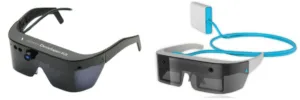Atheer Labs (Mountain View, CA) has developed an interactive, 3D, augmented reality “platform” which combines immersive 3D augmented reality with “natural” gesture-based interaction. The so-called Atheer AiR platform consists of a virtual reality user interface called Augmented interactive Reality or AiR OS and the so-called AiR smartglasses.
There is a bit of interesting history regarding the path followed by Atheer to get to its current product state of development. In 2014, Atheer launched an Indiegogo crowd funding campaign offering augmented reality glasses to consumers. The campaign was successful – raising more than $200,000. Nonetheless, the company canceled the campaign citing greater interest from the enterprise side. The company is now targeting applications such as medical, oil, gas and the logistics industries.
The glasses are see-through and allow the user to see information overlaid onto a view of the real world. In addition, the smartglasses have the capability to detect the movements of the user’s hands. The system determines the user’s fingertips position and orientation enabling the user to interact with applications using gestures.
The company manufactures its own branded smartglasses. At this time, an Atheer Developer Kit called the AiR DK2 is available.
The Atheer technology currently runs on a small Wi-Fi-connected device that connects to the Smart Glasses. The company believes that, at some point, it should be possible for hardware makers to build the Atheer software layer into their own hardware. In one scenario, the Atheer software might be powered by a consumer smartphone.
The software “sits on top” of open-source Android. The Android-based system is backwards compatible. It is therefore possible to run the vast number of applications found on Android Play and to do so without modification. When using the system’s legacy 2D mode, the glasses display images as if they were on a tablet floating in front of the user.
A first rate video illustrating the glasses and software concepts in operation can be found at the end of this article. The company claims to have demonstrated that it is possible to implement most of the features in this video. This includes:
- Intuitive, precise gestures and interactions such as air touch, tap, swipe, hover, rotate, spin, pinch and zoom. The company reports working on a gesture building tool that will enable developers to build and recognize their own custom gestures.
- The ability to connect to peripheral devices.
- The ability to use multiple types of inputs such as voice and head motion/position tracking.
A Software Development Kit (SDK) is now available from the company. This is the second version of the SDK that has been released.
The company offers a Partner Support Portal. At this site, users can get access to the latest updates, tutorials, code samples and developer guidelines. Company Customer Engagement Specialists are on-hand to assist with development.
In order to make sure that the company can scale production to meet anticipated customer requirements, Atheer reports working with one of the world’s largest contract manufacturers.
At this time, there is no public pricing information or specs for the smartglasses. The release date has been reported as late 2015. – Arthur Berman

